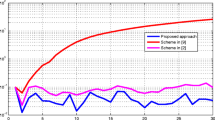Abstract
Target tracking using distributed sensor network is in general a challenging problem because it always needs to deal with real-time processing of noisy information. In this paper the problem of using nonlinear sensors such as distance and direction sensors for estimating a moving target is studied. The problem is formulated as a prudent design of nonlinear filters for a linear system subject to noisy nonlinear measurements and partially unknown input, which is generated by an exogenous system. In the worst case where the input is completely unknown, the exogenous dynamics is reduced to the random walk model. It can be shown that the nonlinear filter will have optimal convergence if the number of the sensors are large enough and the convergence rate will be highly improved if the sensors are deployed appropriately. This actually raises an interesting issue on active sensing: how to optimally move the sensors if they are considered as mobile multi-agent systems? Finally, a simulation example is given to illustrate and validate the construction of our filter.
Similar content being viewed by others
References
J. Agre and L. Clare, An integrated architecture for cooperative sensing networks, Computer, 2000, 33(5): 106–108.
S. Kumar, F. Zhao, and D. Shepherd, Collaborative signal and information processing in microsensor networks, IEEE Signal Processing Magazine, 2002, 19(2): 13–14.
R. Brooks, P. Ramanathan, and A. M. Sayeed, Distributed target classification and tracking in sensor networks, in Proc. of IEEE, 2003, 91(8): 1163–1171.
D. Cheng, B. Ghosh, and X. Hu, Distributed sensor network for target tracking, in Proc. of the 17th International Symposium on Mathematical Theory of Networks and Systems, Kyoto, July 24–28, 2006.
A. H. Jazwinski, Stochastic Processes and Filtering Theory, Academic Press, New York, 1970.
K. Reif, S. Gunther, E. Yaz, R. Unbehauen, and BMW AG Munich, Stochastic stability of the continuous-time extended Kalman filter, in IEEE Proc. Contr. Theory and Appl., 2000, 147(1): 45–52.
B. D. O. Anderson and J. B. Moore, Optimal Filtering, Prentice-Hall Inc., New Jersey, 1979.
T. J. Tarn and Y. Rasis, Observers for nonlinear stochastic systems, IEEE Trans. Automat. Contr., 1976, 21(4): 441–448.
E. D. Sontag, Mathematical Control Theory: Deterministic Finite Dimensional Systems, Springer-Verlag, New York, 1990.
R. A. Horn and C. R. Johnson, Topics in Matrix Analysis, Cambridge Univ. Press, New York, 1991.
F. Zhao, J. Shin, and J. Reich, Information-driven dynamic sensor collaboration for tracking applications, IEEE Signal Processing Magazine, 2002, 19(2): 61–72.
Author information
Authors and Affiliations
Corresponding author
Rights and permissions
About this article
Cite this article
Hu, J., Hu, X. OPTIMAL TARGET TRAJECTORY ESTIMATION AND FILTERING USING NETWORKED SENSORS. J Syst Sci Complex 21, 325–336 (2008). https://doi.org/10.1007/s11424-008-9116-8
Received:
Revised:
Published:
Issue Date:
DOI: https://doi.org/10.1007/s11424-008-9116-8




